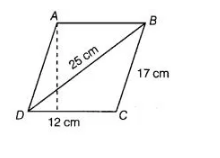Find the area of a parallelogram given in the figure. Also, find the length of the altitude from vertex A on the side DC.

Thinking process
(i) Determine the area of ABCD by using Heron’s formula.
(ii) Using relation, area of parallelogram ABCD =2 (Area of ΔBCD)
(iii) Also, determine the area of parallelogram by using the formula Base x Altitude.
(iv) Further, equating the area of parallelogram in (ii) and (iii). Obtain the required length of the altitude.
Area of parallelogram $\quad A B C D=2$ (Area of $\triangle B C D$ ) $\ldots(\mathrm{i})$
Now, the sides of a $\triangle B C D$ are $a=12 \mathrm{~cm}, b=17 \mathrm{~cm}$ and $c=25 \mathrm{~cm}$.
$\therefore \quad$ Semi-perimeter of $\triangle B C D, s=\frac{a+b+c}{2}=\frac{12+17+25}{2}=\frac{54}{2}=27 \mathrm{~cm}$
$\therefore \quad$ Area of $\triangle B C D=\sqrt{s(s-a)(s-b)(s-c)} \quad$ [by Heron's formula]
$=\sqrt{27(27-12)(27-17)(27-25)}$
$=\sqrt{27 \times 15 \times 10 \times 2}$
$=\sqrt{9 \times 3 \times 3 \times 5 \times 5 \times 2 \times 2}$
=3 x 3 x 5 x 2 cm2
Area of parallelogram ABCD = 2 x 90
= 180 cm2 …(ii)
Let altitude of a parallelogram be h.
Also, area of parallelogram ABCD =Base x Altitude
=> 180 = DC x h [from Eq. (ii)]
=> 180 = 12 x h
∴ h = 180/12= 15 cm
Hence, the area of parallelogram is 180 cm2 and the length of altitude is 15 cm.
